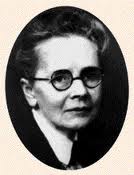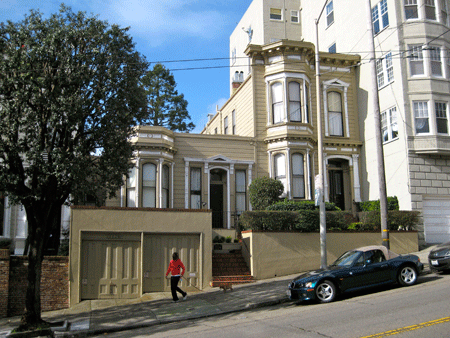ARCHITECTURE | ERICA REDER
Every year thousands of people visit a building designed by California’s most celebrated female architect, Julia Morgan. Some seek out her work by taking a tour of Hearst Castle or the Berkeley City Club. Others have incidental encounters while walking around the Mills College campus, swimming at UC Berkeley’s Hearst Pool or meditating at the San Francisco Zen Center.
It also happens closer to home. The prodigious Morgan designed at least 15 homes and other buildings in the neighborhood and remodeled several more. A closer look also reveals insights into her life and times.
Born in 1872, Morgan’s formative years coincided with the development of Pacific and Presidio Heights. While she enjoyed a comfortable childhood in Oakland, the new San Francisco neighborhoods were fast becoming a sought-after address.
The construction of cable car lines in the 1870s and 1880s added convenience to the area’s natural charms, and many of the city’s wealthy residents began building homes here. In 1887, the Chronicle labeled the area “one of the most desirable situations for residences to be found anywhere,” adding: “In no locality has there been more activity in the building of residences during the past six months.”
About the same time, Morgan was embarking on her path to becoming an architect. In 1890, she enrolled at UC Berkeley’s College of Engineering. Degree in hand, she left for Paris six years later, where she became the first woman to receive an architecture certificate from the prestigious Ecole des Beaux-Arts. The Chronicle noted the occasion, predicting that Morgan would “probably practice her profession in San Francisco.”
Morgan proved the prediction right when she returned home in 1902. She worked for a UC Berkeley architect briefly before striking out on her own. After taking the state certification exam in 1904, she achieved another historical distinction as the first American woman to head her own architecture firm.

Julia Morgan
In those first years, Morgan relied on connections to obtain commissions. Karen McNeill, a Julia Morgan scholar, says family and education helped secure Morgan’s first clients. “She got all of her work through word of mouth,” says McNeill, “and often there was a link to her family or to a women’s club or to her sorority. Things did extend from there, but usually there was some kind of network link.”
Through academic and professional ties to UC Berkeley, Morgan met her first high-profile patron: Phoebe Hearst. The philanthropist approached Morgan with a request for a country house in 1903, even before Morgan had established her San Francisco practice. Later that year, Susan Mills, president of Mills College and purported friend of Morgan’s mother, entrusted the fledgling architect with designing the campus bell tower and library.
Executing these projects with utmost competence, Morgan quickly acquired a good reputation. Dorothy Coblentz, an architect who worked for Morgan’s firm in the 1920s, confirmed Morgan’s ability to gain commissions on her own merit. “People kept coming to her,” said Coblentz in an interview for the Julia Morgan Architectural History Project. “Every job she did was satisfactory to clients.”
Connections would play a role in Morgan’s work in Pacific Heights. One of the earliest houses she designed in the area belonged to Aurora Stull, whose daughter had been a classmate of Morgan’s at UC Berkeley. Built in 1908, the house at 3377 Pacific Avenue demonstrates Morgan’s interest in the Arts and Crafts style. Emphasizing natural materials and forms, the movement gained popularity in turn-of-the-century California. Redwood shingles and large windows create harmony between the building and its location facing the Presidio, following Arts and Crafts principles.
Morgan’s aesthetic influences included many other styles, which she highlighted in response to clients’ requests. In 1916, she designed a Mediterranean-inspired building for the Katherine Delmar Burke School at 3065 Jackson Street, now home of San Francisco University High School. The same year, she designed a house at 3630 Jackson Street that incorporated Tudor elements. The client — dried fruit tycoon Abraham Rosenberg, typified Morgan’s illustrious patrons in the neighborhood. They included Reverend Bradford Leavitt, minister of the First Unitarian Church; Edwin Newhall, millionaire import-export businessman; and Alfred Holman, editor and owner of The Argonaut.
Despite her prominent clientele, Morgan kept a low profile. “She looked like a nobody,” said Coblentz, commenting on her boss’s diminutive figure and sensible dress. “She couldn’t have looked less distinguished.”
True to her discreet taste, Morgan’s own home was anything but ostentatious. In the 1920s she bought side-by-side Victorians at 2229 and 2231 Divisadero Street, which she remodeled into one property. She removed the top floor from the downhill home to allow more light into the apartments she created uphill. Otherwise, the buildings bear little external mark of her influence.
Belinda Taylor, author of the play “Becoming Julia Morgan,” says the property’s modesty reflected Morgan’s financial situation. “It was not a mansion,” Taylor says. “She had no illusions about being wealthy and about having wealth. She really never earned a lot of money herself.”
McNeill agrees. “She bought a house to provide for income,” says the scholar. “She rented out spaces.” McNeill says Morgan’s tenants were “almost always professional women — sometimes her employees, but not necessarily.” Morgan’s living arrangements reveal more than her financial situation: They also touch on what Taylor calls the “essential mystery” of the influential architect. “She never married and had no known love affairs,” says Taylor. “She was a pretty young woman; there was no reason.”
Speculation abounds about Morgan’s romantic situation. Coblentz thought Morgan simply worked too hard. “Nobody could lead a normal life working as she did,” Coblentz says. “She couldn’t have had any private life.”
Morgan’s niece disagreed. In an interview for the architectural history project, Morgan North said her aunt “just was not the type that was at all interested in men.”
Either way, the architect’s fierce privacy continues to intrigue people. “She did not give interviews. She did not write,” says playwright Taylor. “She’s a woman of mystery.”
Mysterious is one way to describe Morgan; superhuman is another. By the time she died in 1957, she had worked on more than 700 buildings. Reports suggest that she did so with minimal sleep and food. “Every architect who ever worked with her said the only problem with her was that they couldn’t live on Hershey bars and coffee, even though she did,” niece Flora North told the history project.
Dynamo and enigma: Both sides of Julia Morgan live on in the neighborhood.
Filed under: Art & Design, Locals, Neighborhood History





